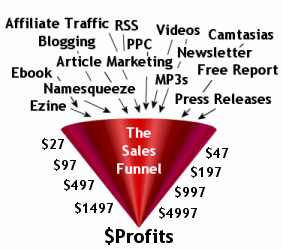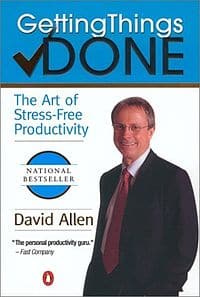I?ve been thinking a lot about my plans for the coming months and the start of the new year.
There?s a lot I want to release next year and it?s all wrapped around a strategy that essentially rests on finally getting myself a proper sales funnel of my own products (if you?re new to the Sales Funnel concept, read my introductory series of articles starting here).
This strategy has a lot of layers to it and each layer contains many tasks that need to get done. There?s everything from product creation, to sales pages, email sequences, product delivery, traffic generation, conversion, content creation, and all the bits and pieces that go together for a typical information product business.

I?ve never properly set up a sales funnel, so I?m excited by the potential and motivated to make it happen. I have a lot of untapped leverage within my existing work, so much of this process will be about releasing ?hidden? profits and distributing my content to new places.
No doubt much of what I have described is on your to-do list as well. There?s a never ending list of tasks like this for an information marketer. The unfortunate side effect is feeling overwhelmed, that you are working hard but not getting anywhere.
To make this process more effective, a big part of my strategy is to sequence the tasks in the right order. For example, there?s no point working on traffic building techniques if you?ve got no way to leverage the traffic you bring in.
To help accomplish these tasks, and more importantly, to reduce my stress, eliminate feelings of overwhelm and give me a clear order of tasks to focus on, I am completing a process of brain dumping and prioritization.
The Brain Dump Technique
To put it simply, a brain dump is taking all the things you are thinking about, worrying about and mulling over that you have to do or that takes your attention, and ?dumping? it into a document.
 My preferred tool for brain dumping used to be good old fashioned pen with a big notebook, but lately I?m more of an Evernote devotee because of the cloud based back-up. There is still something satisfying about using pen and paper though, seeing that big list of scribble that just spewed forth from your brain gives you a sense of clearing space.
My preferred tool for brain dumping used to be good old fashioned pen with a big notebook, but lately I?m more of an Evernote devotee because of the cloud based back-up. There is still something satisfying about using pen and paper though, seeing that big list of scribble that just spewed forth from your brain gives you a sense of clearing space.
Entrepreneurs often struggle to sleep because during the evening you mentally review all the things you have to do. To make matters worse, usually while in bed you?re not in work mode, so you don?t go and start to complete a task. Instead you are trapped in your bed, thinking about what you have to do which leads to more things you have to do. It?s stressful because all you do is open loops, never closing them. Obviously it is not conducive to a good nights rest.
Personally I have no issues falling asleep, I tend to only suffer from this problem when I wake up in the early morning before I get my eight hours of necessary shut-eye. That?s when my nervous system is out of whack from being undercooked, which leads to my head reviewing my previous day and what?s coming up in the new day. If I get carried away, my thoughts turn to a complete life-review, which I have to stop myself from doing if I want to get back to sleep.
The brain dump is a great antidote to the sleepless entrepreneur problem, if you let it be.
The key after doing a brain dump, is that you must allow yourself to rely on whatever tool you just used to clear your head. The notes you have taken are not to be pondered until it?s work time, and then only to pick your next task for that day.
If you brain dump and just continue to think about everything, that?s not a proper clearing process. You need to essentially ?forget? about the issue until it?s the right time to focus on it. That?s why you have to trust your notes ? everything is there when you need it so you don?t have to worry about it.
Prioritization Is Next
 If you have followed the advice offered by the popular book ?Getting Things Done? by David Allen, you will be aware of the idea of always having a device to jot down tasks (a notepad and pen, or your mobile phone for example) and then grouping them into projects and prioritizing.
If you have followed the advice offered by the popular book ?Getting Things Done? by David Allen, you will be aware of the idea of always having a device to jot down tasks (a notepad and pen, or your mobile phone for example) and then grouping them into projects and prioritizing.
I like the principles and techniques David teaches, but I have to admit I found his full system too much. The task of collecting and prioritizing became a big task in itself. I found it overkill, I can function with something simpler.
My process of prioritization is somewhat free-flowing to match my lifestyle (and personality I suppose too). I stick to timeframes based on what I need to do to keep the status quo running smoothly (blog posts, emails, existing commitments coming up during the week such as interviews) and do these things early to create time to get the moving forward tasks done during the rest of the week.
To decide what part of a new project to work on during my moving forward time, I take into account two variables -
- What makes sense to work on now based on a logical order
- What I feel like doing in the moment
When I say ?logical order? this is my own internal strategizing process. I use the 80/20 Rule, the Theory of Constraints and my own experiences to decide what needs to get done first.
It?s not really that tricky when you think about, it makes common sense to do certain things before others.
For example, right now I?m working with two contractors to get info products ready for the new year. Hence at the moment I focus all my new project time on the product delivery aspects such as ?
- Creating product
- Setting up product delivery technology
- Payment processing system
- Sales pages
It makes sense for me to focus on these aspects now, so when I send traffic to my site and people join my newsletter, I have products they can buy and benefit from.
I could spend my time working on video marketing, or optimize and increase the number of podcasts I do, or write more blog content, or focus on my affiliate program, or any number of things. If however I don?t have my sales and conversion process established, most of those activities will just make me more ?busy?, not significantly more profitable.
At the moment I monetize primarily via advertising and affiliate income. Solid revenue sources for sure, but not in my experience as good as having your own product (in terms of financial return, personal gratification and business building).
What?s more important to me now, which I should have focused on years ago, is setting up a funnel that converts and determine my visitor value (how much on average one person joining my funnel is worth to my business). From there I can go to work increasing traffic.
There?s no point filling a boat with people if it?s full of leaks. Fix the leaks first, then sell tickets.
Mood Swings
One area that people rarely talk about when it comes to task prioritization is mood and energy. This is unfortunate because I believe mood management as a technique for energy efficiency is potentially the most important aspect of productivity.
I?m not going to pester you with the basics of body health. You obviously know it is important to eat small regular healthy meals, to get a good nights rest and exercise. These are core practices to set in place to keep your machine ? your body ? running at optimum levels. The rest of the process is all about managing your energy levels, choosing to do the right task to match where your body is at.
For example I?m typing this at a chocolate and coffee shop in the Brisbane CBD with an entire afternoon of available time (I?m drinking tea by the way). I started writing at 2pm, the first business related work I have done today. I have a solid amount of distraction-free time available, I feel motivated to create and I have food in my belly. That?s an optimal situation for me to put in a good couple of hours of writing, which I have.
If it was late at night and I was tired, but not quite ready for bed tired, I?m not about to start writing an article. I need to be fresh for that. Instead this is a time to do smaller tasks, but still tasks that can help move my new projects forward.
For example, I need to assign tasks and give materials to a tech contractor, so she can get my new products ready for download. Do this I just write some short instructions and attach some files into a to-do in Basecamp. When I wake up the next day, chances are the work will already be done.
Perhaps because I?ve had such a flexible work schedule for so long (I?ve been an internet entrepreneur for nearly 13 years), I?ve always been very responsive to my moods (you might say a little too responsive!). Most people have to force themselves to work while tired, or do tasks they hate as part of a job. If I?m tired, I have a nap. If I?m hungry, I eat now, not on some kind of schedule someone else decided upon. I get to pick the tasks I do, so most of the time I do things I like, for example, write this article you are reading now.
It?s important not to fight your energy and moods, but to leverage them. Work with your energy flows, don?t fight them, assuming you have your basics covered with good body health.
If you have an hour spare to listen to some great training on energy management from Tony Schwartz, in a presentation he did for the staff at Google ?
Brain Dump, Prioritize And Work With Your Energy
Do you want a recipe for a productive day? Well you have one now?
I?ve just given you a very powerful, yet simple in concept, three-step formula:
- Brain Dump everything on to paper or a digital tool so you don?t have to waste energy thinking about all of it and get a good night sleep
- Prioritize your notes into tasks based on a logical order of performance
- Work on the tasks, being mindful to align your body, mood and energy levels with the type of effort required to get the job done.
You can also use these techniques for your entire life, it does not have to be about your business. It can be caring for your family, or planning an exercise program, or completing a university degree. Everything can be removed form your head, sorted into tasks, prioritized by what matters most to you and what you can get done given your current energy levels.
At the very least, try the brain dump technique. Getting things out of your head and forgetting about them is a huge stress reliever. I use it every day on a micro level by brain dumping a short list of two-to-five tasks to do that day, if I can. That?s all I think about when it comes to work for that day, the rest I leave for another day, so I don?t think about. If I do think of something, it gets brain dumped, ready to be put on a daily to-do list in the future.
Enjoy your day!
Yaro Starak
Brain Dumping
Photo courtesy of TEDxPioneerValley2012
Source: http://www.entrepreneurs-journey.com/11343/brain-dumps-prioritization-and-productivity/
michael dyer suspended new years ball drop new years rockin eve new york times square jaws first night ball drop
No comments:
Post a Comment
Note: Only a member of this blog may post a comment.